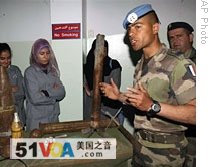Geneva
04 April 2009
 |
| A UN peacekeeper (R) shows cluster bombs and munitions to school children at a mine-risk education session in Lebanon, 04 Apr 2009 |
Ten years ago, an International Convention banning the use, production and stockpiling of anti-personnel landmines was enacted. Since then, casualty rates have decreased, large tracts of land have been cleared and returned to productive use, and over 42 million stockpiled mines have been destroyed by states that are parties to the treaty.
Nevertheless, landmines and other explosive remnants of war remain a menace. The UN Children's Fund said more than 70 states still are affected by landmines and more than 25 states are contaminated by unexploded cluster bombs and sub-munitions.
UNICEF Program Officer for Mine Action Sharif Baaser told VOA the harmful effects of landmines and exploded remnants of war continue long after a war ends.
"Affecting children, civilians, communities, blocking access to communities and also it is a huge hurdle and obstacle for development," he said.
Some of the most heavily mine-infested countries include Afghanistan, Cambodia, Angola, Sudan, Bosnia, Iraq and Lebanon.
 |
| A personnel land mine (R) and a snow mine (File) |
Baaser said children, particularly boys, are most likely to be harmed. They account for about one-third of all victims of landmines and exploded remnants of war. He said they get killed or injured while going about their daily activities.
"Some of them are engaged in agriculture, in subsistence communities. Some of them are like children who go to school or traveling. They step on these weapons or find them and take them as toys and play with them or handle them and then it goes off and the casualties are, most of the time, traumatic, many deaths and many injuries as a result," he said.
Baaser said the injuries can include loss of arms and legs, sight or hearing and often cause lifelong disabilities.
156 states have joined the 1997 Mine Ban Convention. Notable holdouts include the United States, China and Russia.
Activists said even states that have not joined the treaty do not use landmines because of the stigma attached. They say only two governments - Burma and Russia - and a handful of non-state armed groups have employed the weapon in the past few years.